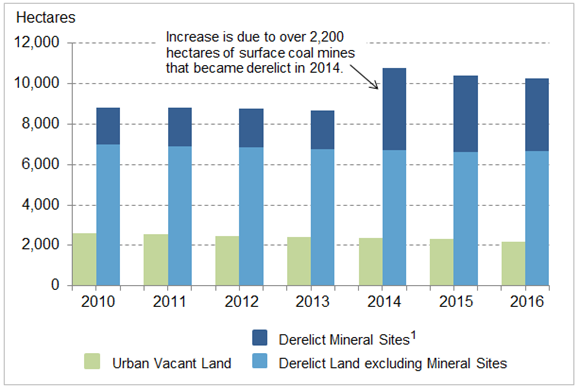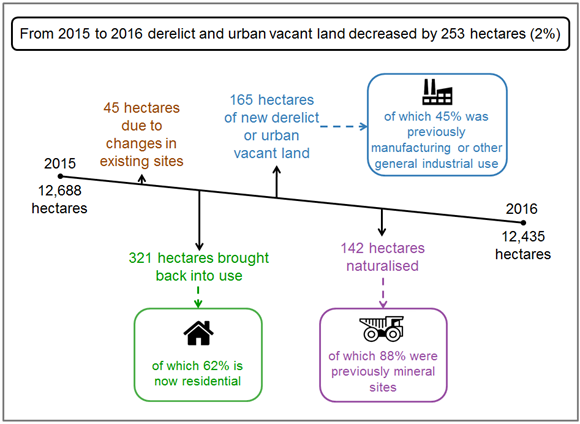Decrease in derelict and urban vacant land
A National Statistics Publication for Scotland.
The total amount of derelict and urban vacant land in Scotland decreased by 253 hectares (two per cent) from the previous year, to 12,435 hectares in 2016.
Scotland’s Chief Statistician has today released the latest annual statistics on the extent of vacant and derelict land in Scotland.
- Mineral sites include sites where there was previously coal, crushed rock, sand/gravel, shale, fireclay, limestone or other mineral activity.
Data from the 2016 Scottish Vacant and Derelict Land Survey gives the following results:
The total amount of derelict and urban vacant land in Scotland has decreased by 253 hectares (2%) in the latest year, from 12,688 hectares in 2015 to 12,435 hectares in 2016.
The decrease of 253 hectares (2%) between 2015 and 2016 is explained by 321 hectares that were brought back into use and 142 hectares that were naturalised (93 hectares of which is for a former surface coal site in East Ayrshire). This balances against 165 hectares of new derelict and vacant land reported by local authorities, along with a net increase of 45 hectares due to changes in existing sites.
The most common new use for derelict and urban vacant land was residential, with 62% (199 hectares) of the land that was brought back into use since the previous survey reclaimed for this purpose.
Of the 165 hectares of new derelict and urban vacant land reported by local authorities, the most common previous land uses were related to manufacturing or other general industrial uses, which accounted for 75 hectares or 45% of new land reported.
The total amount of derelict and urban vacant land has decreased in each year between 2010 and 2016 (annual decreases ranging from 0.2% to 3%), except for 2014 when there was an increase of 2,090 hectares (19%) compared to 2013, largely due to over 2,200 hectares of former surface coal mine sites in East Ayrshire that had become derelict following the liquidation of Scottish Coal and ATH Resources in 2013.
These annual changes have combined to show a cumulative increase of 1,064 hectares (9 per cent) in the total amount of derelict and urban vacant land recorded since 2010, from 11,372 hectares in 2010 to 12,435 hectares in 2016. However when excluding derelict mineral sites there has been a cumulative decrease of 741 hectares (8%) in the total amount of derelict and urban vacant land since 2010.
Of the 12,435 hectares of derelict and urban vacant land recorded in the 2016 survey, 2,156 hectares (17%) were classified as urban vacant and 10,279 hectares (83%) were classified as derelict.
The local authority with the largest amount of recorded derelict and urban vacant land is East Ayrshire, containing 2,457 hectares (20% of the Scotland total). Highland has the second largest amount with 1,342 hectares (11%), North Ayrshire is third with 1,330 hectares (11%), followed by North Lanarkshire with 1,222 hectares (10%) then Glasgow City with 1,111 hectares (9%).
30.3% of Scotland’s population are estimated to live within 500 metres of a derelict site in 2016, a figure that varies by local authority area from 0.6% in Orkney, 0.9% in Shetland and 4.6% in Na h-Eileanan Siar to 61.1% in Glasgow, 61.7% in West Dunbartonshire and 73.4% in North Lanarkshire.
59% of people living in the most deprived decile in Scotland are estimated to live within 500 metres of derelict land, compared to 13% of people in the least deprived decile.
For those sites where the previous use is known, 36% of derelict land recorded in 2016 had been previously used for mineral activity (3,606 hectares), 19% for defence (1,906 hectares), and a further 19% for manufacturing (1,859 hectares). The most common previous use for urban vacant land, where previous use is known, was agriculture (18%, or 328 hectares) and the second most common previous use was residential development (17%, or 318 hectares).
3,189 hectares (28%) of derelict and urban vacant land in 2016 was reported to be developable in the short term, with an expectation of development within five years. A total of 2,918 hectares (26%) of derelict and urban vacant land is seen by local authorities as being uneconomic to develop and/or is viewed as suitable to reclaim for a ‘soft’ end use (i.e. non-built use).
Of the 321 hectares of derelict or urban vacant land reused in 2016, a total of 90 hectares (28%) involved some form of public funding, either a full or partial contribution.
Since its inception in 2005/06, the Scottish Government’s Vacant and Derelict Land Fund has contributed (either fully or partially) to the reuse of 367 hectares (in total) of previously derelict and urban vacant land across Dundee City, Glasgow City, Highland, North Lanarkshire, South Lanarkshire and more recently Fife.
The figures released today were produced in accordance with professional standards set out in the Code of Practice for Official Statistics.
Background
The full statistical publication is available alongside Excel versions of tables and charts, a site-level dataset, and selected maps.
The publication contains a summary of results from the 2016 Scottish Vacant and Derelict Land Survey along with commentary and tables on longer term trends.
Dumfries & Galloway, East Lothian, Highland and West Lothian did not update their survey in 2016 and so data for these local authorities is carried over from 2015.
The main purpose of the statistics is to provide a national data source to inform the programming of rehabilitation, planning and reuse of urban vacant and derelict sites. The statistics contribute to the Government's performance indicator for sustainable communities that measures progress on Housing and Regeneration outcomes. Further information on this can be found at:
http://www.gov.scot/Topics/Built-Environment/Housing/reform/HARO/Indicators
Official statistics are produced by professionally independent statistical staff – more information on the standards of official statistics in Scotland can be accessed at: http://www.gov.scot/Topics/Statistics/About
There is a problem
Thanks for your feedback

